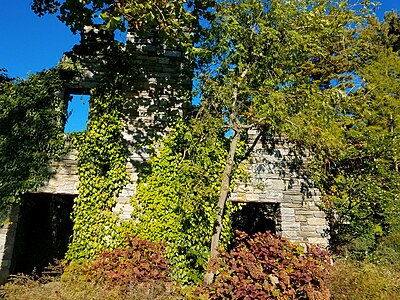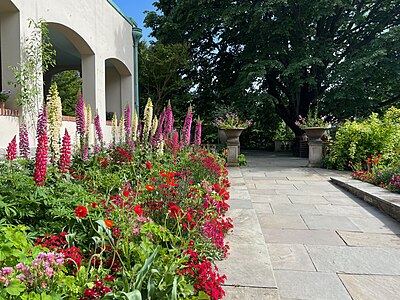
The Birmingham Botanical Gardens are a 15-acre (6-hectare) botanical garden situated in Edgbaston, Birmingham, England. The gardens are located 1+1⁄2 miles (2.4 km) south-west of Birmingham city centre at grid reference SP049854. Designed in 1829, the gardens are Grade II* listed in Historic Englands's Register of Parks and Gardens, and retain many original features and layout, which was designed by the landscape gardener and horticulturalist John Claudius Loudon. The site is notable for its range of glasshouses and gardens, which display a wide variety of plants and birds. Birmingham Botanical Gardens is managed by Birmingham Botanical and Horticultural Society, a registered charity. The gardens are open daily to the public with paid admission.

The City Botanic Gardens is a heritage-listed botanic garden on Alice Street, Brisbane City, City of Brisbane, Queensland, Australia. It was also known as Queen's Park. It is located on Gardens Point in the Brisbane CBD and is bordered by the Brisbane River, Alice Street, George Street, Parliament House and Queensland University of Technology's Gardens Point campus. It was established in 1825 as a farm for the Moreton Bay penal settlement.

New England Botanic Garden at Tower Hill is a 171-acre botanic garden and arboretum located in Boylston, Massachusetts, approximately 8 miles (13 km) north of central Worcester in Worcester County, Massachusetts. The Garden features 18 distinct gardens, preserved woodlands, and miles of walking trails.

The Royal Botanic Garden, Sydney is a heritage-listed major 30-hectare (74-acre) botanical garden, event venue and public recreation area located at Farm Cove on the eastern fringe of the Sydney central business district, in the City of Sydney local government area of New South Wales, Australia.

The Government Botanical Garden is a botanical garden in Udhagamandalam, near Coimbatore (Ooty), Tamil Nadu state, India laid out in 1848. The gardens, divided into several sections, cover an area of around 55 acres, and lie on the lower slopes of Doddabetta peak. The garden has a terraced layout. It is maintained by the Tamil Nadu Horticulture Department.

Charleston, in East Sussex, is a property associated with the Bloomsbury group, that is open to the public. It was the country home of Vanessa Bell and Duncan Grant and is an example of their decorative style within a domestic context, representing the fruition of more than sixty years of artistic creativity. In addition to the house and artists' garden, Charleston hosts a year-round programme of Bloomsbury and contemporary exhibitions in a suite of galleries designed by Jamie Fobert Architects which opened in September 2018. Two restored barns are home to The Threshing Barn café and The Hay Barn where events and workshops are held throughout the year. The outer studio at Charleston hosts a permanent display of Bell and Grant's Famous Women Dinner Service, and there is also a shop selling Bloomsbury-inspired art, homeware fabrics, fashion, books and stationery.

Rotary Botanical Gardens is a non-profit 20-acre (81,000 m2) botanical garden located in Janesville, Wisconsin that is open to the public.

The Idaho Botanical Garden, located in the historic Old Penitentiary District of Boise, Idaho, is a 501(c)(3) nonprofit organization dedicated to connecting people, plants, and nature. The Garden serves as a gathering space in the Boise community and advocates environmental stewardship. Spanning 15 acres, the Idaho Botanical Garden is a premier collection of plants cultivated for the unique sagebrush steppe ecosystem of the Treasure Valley aimed at showcasing the region's biodiversity.

Singleton Park is the largest urban park in the city of Swansea. It is located in Sketty and is listed on the Cadw/ICOMOS Register of Parks and Gardens of Special Historic Interest in Wales.

Sutro Heights Park is an historic public park in the Outer Richmond District of western San Francisco, California. It is within the Golden Gate National Recreation Area and the Sutro Historic District.

Luscombe Castle is a country house situated near the resort town of Dawlish, in the county of Devon in England. Upon purchasing the land at Luscombe in 1797, Charles Hoare demolished the existing house and commissioned architects John Nash and Humphrey Repton to design a new house and gardens at the site. Nash and Repton came up with an asymmetrical designed building made from Portland stone, with castellated parapets, turrets and pinnacles to create the feel of a picturesque castle.

The Botanic Garden at Georgia Southern University is a botanical garden featuring many unique and endangered plants with many native to Georgia. The garden's main entrance is located at 1505 Bland Avenue, Statesboro, Georgia, a few blocks from the main Georgia Southern University campus.

Vaucluse House is a heritage-listed residence, colonial farm and country estate and now tourist attraction, house museum and public park located at 69a Wentworth Road, Vaucluse in the Municipality of Woollahra local government area of New South Wales, Australia. Completed between 1803 and 1839 in the Gothic Revival style, its design was attributed to William Charles Wentworth and built by Sir Henry Browne Hayes and W. C. Wentworth. The property is owned by the Historic Houses Trust of New South Wales, an agency of the Government of New South Wales. The site was added to the New South Wales State Heritage Register on 2 April 1999.

Montgomery Place, now Bard College: The Montgomery Place Campus, near Barrytown, New York, United States, is an early 19th-century estate that has been designated a National Historic Landmark. It is also a contributing property to the Hudson River Historic District, itself a National Historic Landmark. It is a Federal-style house, with expansion designed by architect Alexander Jackson Davis. It reflects the tastes of a younger, post-Revolutionary generation of wealthy landowners in the Livingston family who were beginning to be influenced by French trends in home design, moving beyond the strictly English models exemplified by Clermont Manor a short distance up the Hudson River. It is the only Hudson Valley estate house from this era that survives intact, and Davis's only surviving neoclassical country house.

Eglinton Country Park is located on the grounds of the old Eglinton Castle estate in Kilwinning, North Ayrshire, Scotland. Eglinton Park is situated in the parish of Kilwinning, part of the former district of Cunninghame, and covers an area of 400 ha ([98 acres ] of which are woodland. The central iconic feature of the country park is the ruined Eglinton Castle, once home to the Eglinton family and later the Montgomeries, Earls of Eglinton and chiefs of the Clan Montgomery. Eglinton Country Park is managed and maintained by North Ayrshire Council and its Ranger Service.

The South Lawn at the White House in Washington, D.C., is directly south of the house and is bordered on the east by East Executive Drive and the Treasury Building, on the west by West Executive Drive and the Old Executive Office Building, and along its curved southern perimeter by South Executive Drive and a large circular public lawn called The Ellipse.

Historic Spanish Point is a 33-acre (13 ha) museum and environmental complex located in Osprey, Florida at 337 North Tamiami Trail. The museum includes an archeological exhibit of a prehistoric shell mound known as a midden, a turn-of-the-century pioneer homestead historic house museum, a citrus packing house, a chapel, boatyard, gardens, and nature trails.

James Gardens is a public botanical garden in the Etobicoke district of Toronto, Ontario, Canada along the Humber River. It was a former private estate sold to the City of Toronto and now managed by the Toronto Parks Department.
The Farm House is a historic summer estate at 15 Highbrook Road in Bar Harbor, Maine. The estate includes a 19th-century farmhouse which was extensively altered in the 1920s to Colonial Revival designs by Arthur McFarland, who also designed a caretaker's cottage on the property. The property also includes a series of garden spaces designed by Beatrix Farrand. This work was done for Mildred McCormick, an heir to the fortune of Cyrus McCormick, inventor of the combine harvester. The estate was listed on the National Register of Historic Places in 2007.

Worsley New Hall is a former mansion and gardens by the Bridgewater Canal in Worsley, Greater Manchester, England, 8 miles (13 km) west of Manchester. The gardens were renovated by the Royal Horticultural Society and opened as RHS Garden Bridgewater in 2021.






























